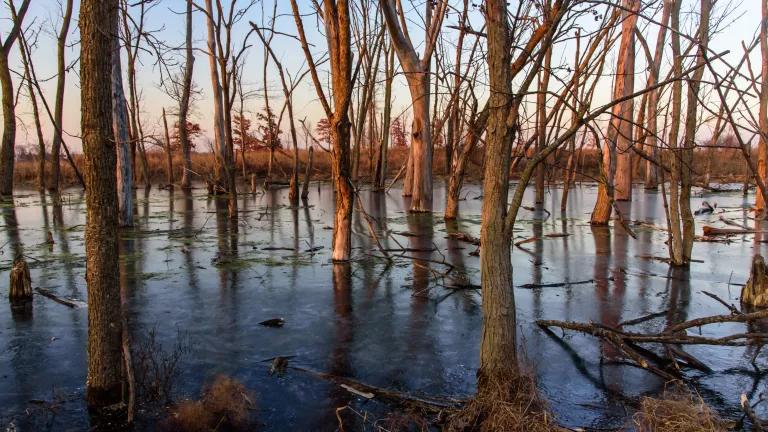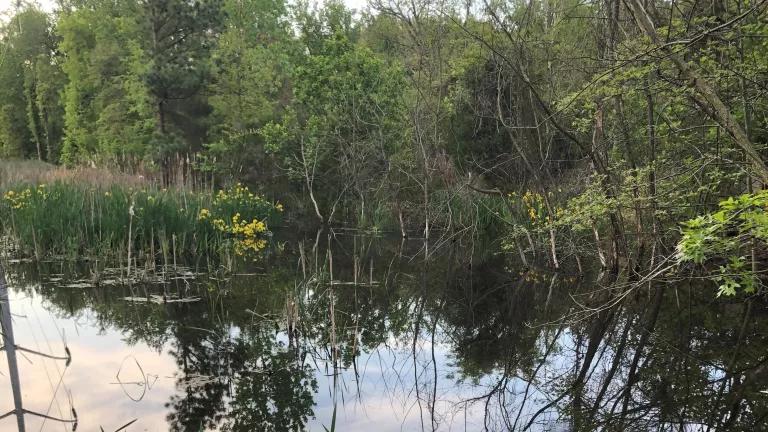The Environmental Protection Agency (EPA) has denied yet another request to toughen up on sources of pollution that are fouling urban waters across the country. NRDC and our partner organizations are disappointed in this response, and more generally, in the agency’s continuing lack of leadership on this issue.
Stormwater runoff is an enormous problem across the United States and is the only growing source of water pollution in many areas. Much of this pollution comes from existing developed sites that were built with minimal or no controls to stop massive quantities of dirty runoff from flowing into our rivers, streams, and lakes. This pollution threatens people’s health, fouls the communities where we live, and impacts our economy by causing beach closures and other lost recreation opportunities.
NRDC has been trying for years to get EPA to use its authority to curb uncontrolled pollution coming off of privately-owned commercial, industrial, and institutional sites. Because these sites contain large impervious areas, like parking lots and rooftops, they consistently discharge large quantities of contaminants into local rivers and streams. But they’re typically not required to take any action to clean up their runoff, especially if they were built prior to adoption of local pollution control ordinances.
Instead, while the polluters get a free pass, municipalities bear the disproportionate burden of reducing stormwater pollution—even though they don’t directly control most of the areas where it’s coming from.
The Clean Water Act provides EPA with a means of better allocating responsibility for cleaning up urban waters. According to the law, when the agency determines that a category of stormwater sources is contributing to water quality violations, EPA must require those sources to apply for permits. In turn, the permits must include requirements for the problem-causing sites to reduce their pollution impacts. This helps to ensure that all polluters do their fair share.
In addition, if these permits were to require the use of green infrastructure practices like rain gardens and green roofs, which capture rain where it falls, they would also help to create healthier neighborhoods and improved quality of life in urban areas.
EPA rarely exercises this authority (called “residual designation authority” or RDA), despite our repeated calls for the agency to do so. In 2013 we petitioned the agency to require permits for all commercial, industrial, and institutional sites discharging into impaired waters in certain sections of the country. EPA rejected these petitions as too broad and lacking sufficient detail.
We disagreed with that conclusion, but we responded by filing a new set of petitions last year. This time we focused on four polluted urban waterways (in Maryland, Delaware, and California) that are in such bad shape they’re unsafe for recreation, fishing, and other uses.
Our petitions provided proof, in the form of GIS analysis and modeling, that commercial, industrial, and institutional sites occupy large portions of these watersheds and contribute to their poor water quality problems. We were joined in these petitions by American Rivers and local groups like Blue Water Baltimore and Los Angeles Waterkeeper who have witnessed the harmful impacts of stormwater runoff first-hand.
But this fall, EPA denied these new petitions, too. You can read those responses here:
- Dominguez Channel (Los Angeles, CA)
- Los Cerritos/Alamitos Bay (Los Angeles, CA)
- Back River (Baltimore, MD)
- Army Creek (New Castle County, DE)
These responses are a clear abdication of the agency’s responsibility to hold polluters accountable.
It’s hard to imagine in what circumstances EPA would ever consider using this authority if the agency doesn’t think our petitions made the grade. After all, EPA Region 9 even agreed that the California petitions met the scientific burden of proof established in the Clean Water Act. (EPA Region 3 disputed that our target sites are causing water quality problems, but we disagree with its conclusions, which are contradicted by many official agency documents in the public record.)
EPA says it’s denying the petitions because existing programs already address the problem these sites create. This is just not true. Municipal stormwater permits in these watersheds contain loopholes that make it less likely discharges from CII sites will be controlled enough to meet water quality standards. And local governments charged with carrying out these duties are falling behind on implementation and developing weak clean-up plans. In fact, EPA Region 3's response documents even acknowledge that the agency has documented instances of local permit violations serious enough to merit hefty fines.
EPA’s argument relies on future promises about what state and local governments are going to do in coming years to combat pollution. But promises can be broken, and they can’t substitute for the legally binding requirements that we need today.
Just as importantly, even if the current approach of relying exclusively on municipalities to get the job done were working, it’s not fair. It places the financial burden on the backs of local governments that struggle to secure adequate resources. That means taxpayers are paying to clean up the mess that large property owners are causing.
We have to make sure private polluters also contribute, even as we continue to hold municipalities accountable for meeting their own obligations. We don’t have to choose one or the other. Eliminating pollution is a team effort.
Denying these petitions misses an opportunity to increase the equity and sustainability of stormwater regulation in this country. We’ve seen a pattern from EPA over the past few years of refusing to step up and deal with this significant environmental problem, starting with the agency’s decision in 2014 to scrap its work on a planned overhaul of its stormwater regulations that would have strengthened requirements nationwide.
Despite this setback, we won’t give up on the use of RDA. We still believe it’s a critical tool that must be used to clean up urban waterways, and we will continue to press EPA to use this essential authority.
*This blog was first posted on October 20 when we received responses from EPA Region 9 and updated on November 4 when we received responses from EPA Region 3.




